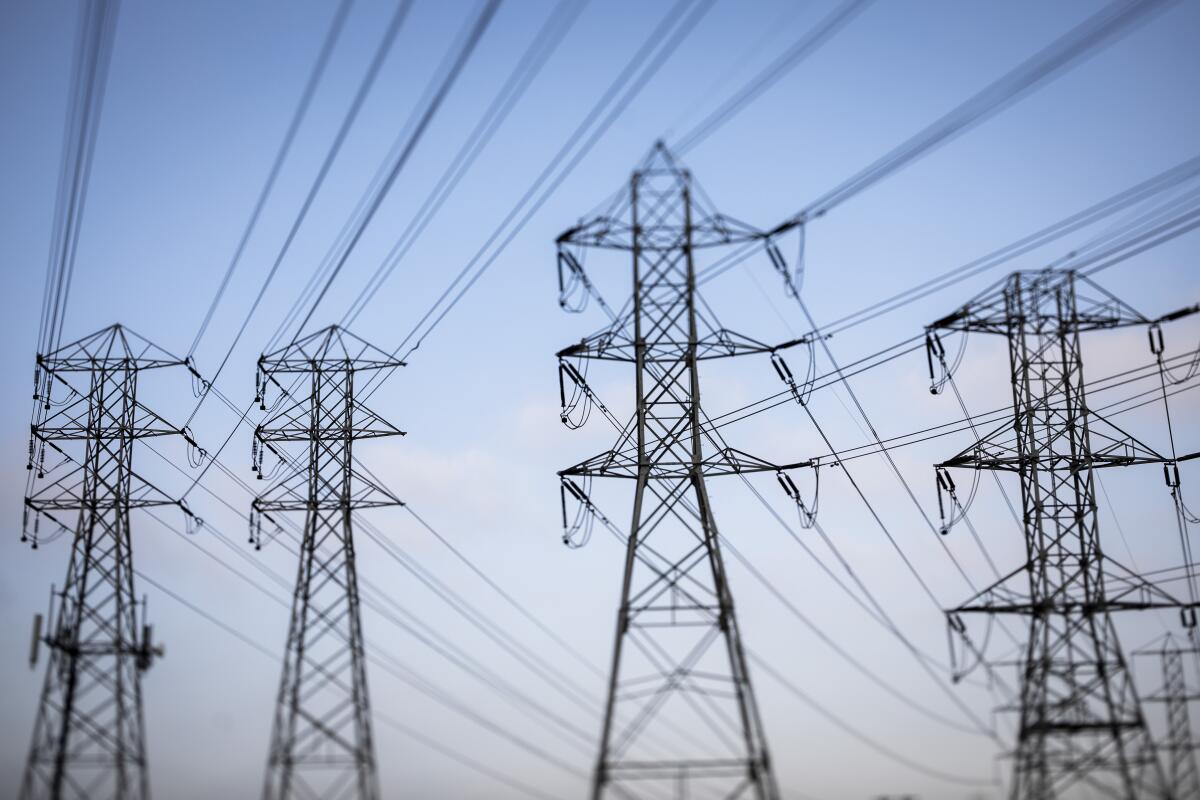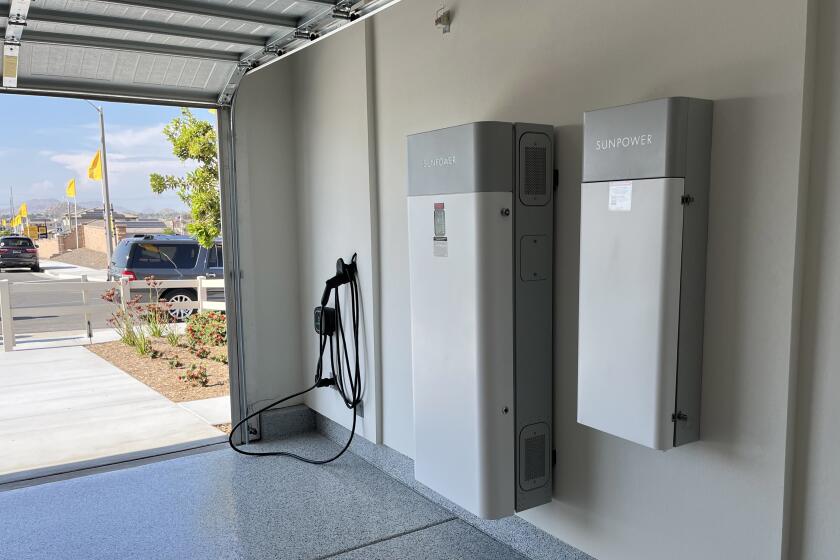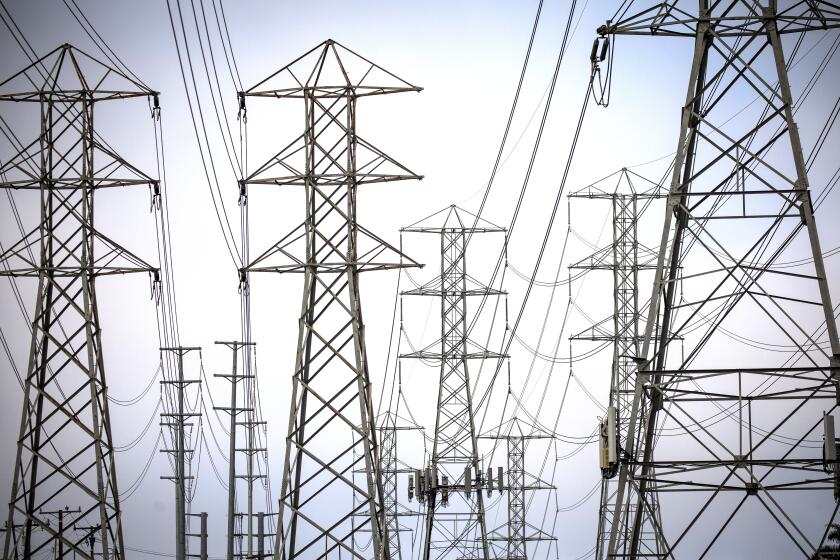Editorial: High electric bills threaten California’s clean future. This plan would help

- Share via
California has some of the nation’s highest electricity rates, and power bills are rising fast. That’s a problem because it makes it harder for people to afford switching from fossil fuels to clean electric cars and appliances that are essential to combating climate change.
Who wants to invest thousands of dollars in a heat pump or induction stove only to be punished with higher bills?
But there’s a proposal by the California Public Utilities Commission that would ease the burden by changing the way customers of the state’s big three investor-owned utilities are billed. Rather than being charged for each kilowatt-hour with rates bulked up to cover capital costs and maintenance, electric customers would pay a modest flat fee (about $24 a month for most households) and a lower per kilowatt-hour rate. It’s a well-thought-out approach to modernizing California’s electric rates that adheres to a 2022 law requiring the commission to adopt income-based fixed rates, and does so without any onerous new income verification program as had been proposed.
The end of Berkeley’s first-in-the-nation ban on gas hookups is a setback for the climate, but a small one. Electric appliances remain better and more efficient.
Change is needed because the existing rate structure used by Southern California Edison, Pacific Gas & Electric and San Diego Gas & Electric, serving most of California’s residents, is based almost entirely on how much electricity each customer consumes. Those usage-based rates cover everything, including grid maintenance, poles and wires, subsidies for low-income customers, energy efficiency programs and rooftop solar, wildfire mitigation and other infrastructure costs.
This payment system may have been appropriate decades ago as a way to encourage energy conservation, but it’s increasingly in conflict with policies pushing residents to electrify their homes and vehicles.
It also puts too much of the burden on lower-income customers. Energy use doesn’t vary as dramatically as income, so Californians who can least afford it are spending a greater share of their earnings supporting utility infrastructure than middle- and upper-class households who can.
Good for European safety ratings group for pushing carmakers to return to manual controls for some car functions. U.S. should do the same. That seems to be what customers want and it’s safer too.
Under the proposal released last month, most electric customers would be charged a $24.15 flat rate on their monthly bill (this would not apply to people who live in Los Angeles or in a handful of other cities that have their own electric utility). That’s the same amount that customers of the Sacramento Municipal Utility District pay each month. Low-income households that qualify for discounted rates under existing assistance programs would pay a flat rate of $6 to $12 a month.
At the same time, consumption-based rates would go down by 5 to 7 cents per kilowatt-hour, depending on the utility, making it more affordable for Californians hit hardest by rising bills, including households in hot inland areas and those who electrify their homes and cars.
It’s far more modest than the proposals by the investor-owned utilities, which sought fixed charges as high as $92 per month. The plan also does away with the controversial income verification requirement that would have been necessary to charge steeper rates to high-income households. (Low-income Californians are already required to show they are eligible to qualify for discounted rates.)
That idea raised some hackles. Earlier this year a group of Democratic lawmakers introduced legislation to repeal the fixed-charge mandate, part of a sweeping energy bill passed in 2022. They should stand down, as the commission’s proposal is a reasonable compromise that rejects the utilities’ radically high proposals.
California is moving to an income-based formula for electric bills. Regulators should proceed cautiously and not give the utilities the high fees they want.
The proposal is supported by consumer watchdog groups such as the the Utility Reform Network and the PUC’s independent Public Advocates Office. If adopted, customers would start seeing the flat fees on their bills starting in late 2025 or early 2026.
The biggest benefits would go to low-income Californians, whose monthly bills would be reduced on average, and those living in hotter inland areas who have to use more energy to cool their homes. Customers who power their homes and vehicles with electricity would save between $28 and $44 a month in the new billing structure. Customers in the cooler regions of the state may see their monthly bills increases, but they have lower-than-average bills to begin with. That seems like a reasonable trade-off to make sure all Californians have an incentive to go electric.
To be clear, this new billing plan doesn’t solve the problem of rising electric bills, and state regulators and lawmakers need to get serious about pushing back against constant rate increase requests and holding these monopolies accountable for keeping costs low. Otherwise, the critical resource that the future of our planet and economy rests on will keep growing less affordable and undermine California’s climate policies.
More to Read
A cure for the common opinion
Get thought-provoking perspectives with our weekly newsletter.
You may occasionally receive promotional content from the Los Angeles Times.













